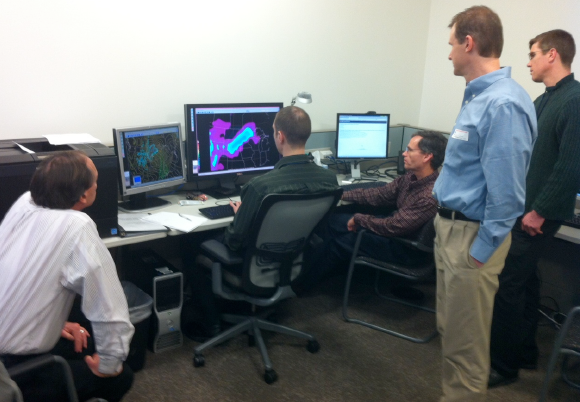HMT-WPC Winter Weather Experiment 2013
May 3, 2013
HMT at the Weather Prediction Center (HMT-WPC) hosted its third annual Winter Weather Experiment from January 15 – February 15, 2013. This year's experiment focused primarily on exploring methods to better quantify and communicate uncertainty in winter weather forecasts through the use of ensemble systems.
Over the course of the five week experiment, 23 forecasters, researchers, and model developers used a combination of experimental and operational model data to issue experimental 24 hour probabilistic snowfall forecasts for either the Day 1 (24 – 48 hr) or Day 2 (48 – 72 hr) period. In addition to the experimental forecasts, participants also subjectively evaluated the experimental model guidance, issued experimental Day 4-5 winter weather outlook forecasts, prepared a public forecast graphic, and provided a mock decision support briefing.
One highlight of the experiment was evaluation of a new method for deriving snowfall accumulations from numerical models. Previous experiments revealed that the snow-to-liquid ratio algorithms typically used in operations have a number of limitations, particularly when the vertical temperature profile only marginally supports snow. The new technique, called the rime factor-modified snowfall accumulation algorithm, uses hourly information from the North American Model's (NAM) microphysics scheme to modify the snow-to-liquid ratio provided by the Roebber Technique (Roebber et al. 2003). The technique accounts for both the amount of riming on individual ice particles and the percentage of precipitation that is frozen. Participants found that these parameters provided valuable forecast information, and HMT-WPC is working with the Environmental Modeling Center (EMC) to expand this methodology to other models.
A new aspect of this year's experiment was the addition of Day 4 and Day 5 winter weather outlook forecasts. These forecasts highlighted areas across the country with a threat for winter weather during the Day 4-5 time frame and provided participants with the opportunity to explore the utility of longer range winter weather forecasts. As a result of the positive feedback received about this product, WPC is investigating expanding its operational winter weather product suite.
The experiment also highlighted the challenges associated with communicating complex meteorological information to decision makers through a mock decision support briefing. During this part of the experiment, participants prepared a public forecast graphic that highlighted where the winter weather event would occur, when the event would occur, and what specific hazards would be associated with it. This graphic was then used as part of the mock briefing.
The 2013 HMT-WPC Winter Weather Experiment provided a unique opportunity to bring the forecasting, research, and model development communities together to explore the challenges associated with winter weather forecasting. The experiment identified several ways to improve and expand WPC's winter weather forecasts which will continue to be explored over the coming year.
Contact: Faye Barthold
